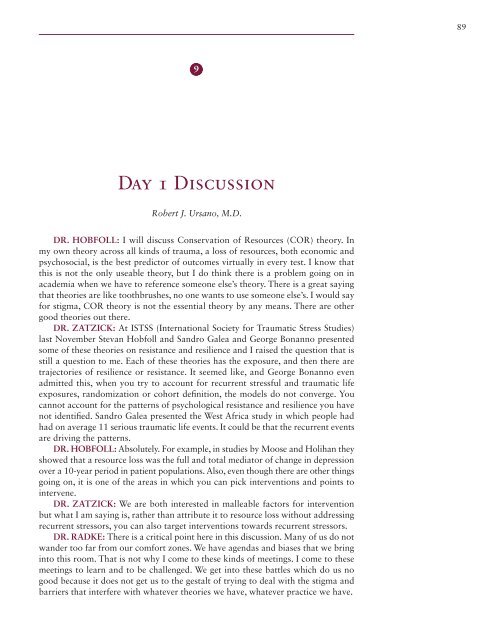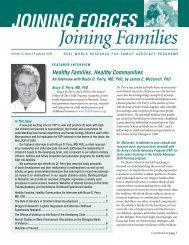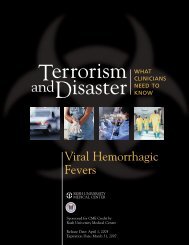stigma and barriers to care - Uniformed Services University of the ...
stigma and barriers to care - Uniformed Services University of the ...
stigma and barriers to care - Uniformed Services University of the ...
Create successful ePaper yourself
Turn your PDF publications into a flip-book with our unique Google optimized e-Paper software.
Day 1 Discussion 89<br />
9<br />
Day 1 Discussion<br />
Robert J. Ursano, M.D.<br />
DR. HOBFOLL: I will discuss Conservation <strong>of</strong> Resources (COR) <strong>the</strong>ory. In<br />
my own <strong>the</strong>ory across all kinds <strong>of</strong> trauma, a loss <strong>of</strong> resources, both economic <strong>and</strong><br />
psychosocial, is <strong>the</strong> best predic<strong>to</strong>r <strong>of</strong> outcomes virtually in every test. I know that<br />
this is not <strong>the</strong> only useable <strong>the</strong>ory, but I do think <strong>the</strong>re is a problem going on in<br />
academia when we have <strong>to</strong> reference someone else’s <strong>the</strong>ory. There is a great saying<br />
that <strong>the</strong>ories are like <strong>to</strong>othbrushes, no one wants <strong>to</strong> use someone else’s. I would say<br />
for <strong>stigma</strong>, COR <strong>the</strong>ory is not <strong>the</strong> essential <strong>the</strong>ory by any means. There are o<strong>the</strong>r<br />
good <strong>the</strong>ories out <strong>the</strong>re.<br />
DR. ZATZICK: At ISTSS (International Society for Traumatic Stress Studies)<br />
last November Stevan Hobfoll <strong>and</strong> S<strong>and</strong>ro Galea <strong>and</strong> George Bonanno presented<br />
some <strong>of</strong> <strong>the</strong>se <strong>the</strong>ories on resistance <strong>and</strong> resilience <strong>and</strong> I raised <strong>the</strong> question that is<br />
still a question <strong>to</strong> me. Each <strong>of</strong> <strong>the</strong>se <strong>the</strong>ories has <strong>the</strong> exposure, <strong>and</strong> <strong>the</strong>n <strong>the</strong>re are<br />
trajec<strong>to</strong>ries <strong>of</strong> resilience or resistance. It seemed like, <strong>and</strong> George Bonanno even<br />
admitted this, when you try <strong>to</strong> account for recurrent stressful <strong>and</strong> traumatic life<br />
exposures, r<strong>and</strong>omization or cohort definition, <strong>the</strong> models do not converge. You<br />
cannot account for <strong>the</strong> patterns <strong>of</strong> psychological resistance <strong>and</strong> resilience you have<br />
not identified. S<strong>and</strong>ro Galea presented <strong>the</strong> West Africa study in which people had<br />
had on average 11 serious traumatic life events. It could be that <strong>the</strong> recurrent events<br />
are driving <strong>the</strong> patterns.<br />
DR. HOBFOLL: Absolutely. For example, in studies by Moose <strong>and</strong> Holihan <strong>the</strong>y<br />
showed that a resource loss was <strong>the</strong> full <strong>and</strong> <strong>to</strong>tal media<strong>to</strong>r <strong>of</strong> change in depression<br />
over a 10-year period in patient populations. Also, even though <strong>the</strong>re are o<strong>the</strong>r things<br />
going on, it is one <strong>of</strong> <strong>the</strong> areas in which you can pick interventions <strong>and</strong> points <strong>to</strong><br />
intervene.<br />
DR. ZATZICK: We are both interested in malleable fac<strong>to</strong>rs for intervention<br />
but what I am saying is, ra<strong>the</strong>r than attribute it <strong>to</strong> resource loss without addressing<br />
recurrent stressors, you can also target interventions <strong>to</strong>wards recurrent stressors.<br />
DR. RADKE: There is a critical point here in this discussion. Many <strong>of</strong> us do not<br />
w<strong>and</strong>er <strong>to</strong>o far from our comfort zones. We have agendas <strong>and</strong> biases that we bring<br />
in<strong>to</strong> this room. That is not why I come <strong>to</strong> <strong>the</strong>se kinds <strong>of</strong> meetings. I come <strong>to</strong> <strong>the</strong>se<br />
meetings <strong>to</strong> learn <strong>and</strong> <strong>to</strong> be challenged. We get in<strong>to</strong> <strong>the</strong>se battles which do us no<br />
good because it does not get us <strong>to</strong> <strong>the</strong> gestalt <strong>of</strong> trying <strong>to</strong> deal with <strong>the</strong> <strong>stigma</strong> <strong>and</strong><br />
<strong>barriers</strong> that interfere with whatever <strong>the</strong>ories we have, whatever practice we have.




